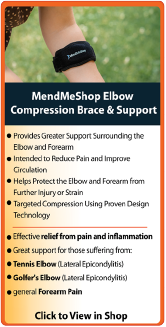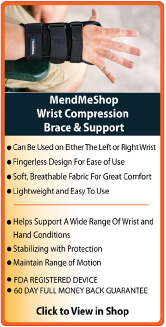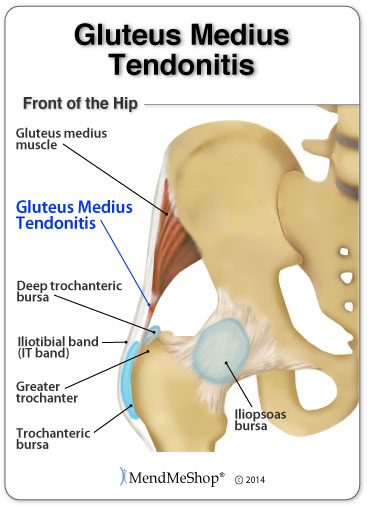|
|
Gluteus Medius TendinopathyWhat are the Symptoms of Gluteus Medius Tendonitis? If you have gluteus medius tendonitis you may experience pain over the outermost side of your hip, the upper side of your buttock and even in the lower back at the spine. You may also experience swelling, warmth or redness around your injury and the pain often gets worse by moving your hip. Weakness in your hip and surrounding muscles and loss of range of motion while moving your leg away from the body are also some common symptoms of this condition. What Causes Gluteus Medius Tendonitis?There are many causes to gluteus medius tendonitis, some of which include:
How Do I Diagnose Gluteus Medius Tendonitis?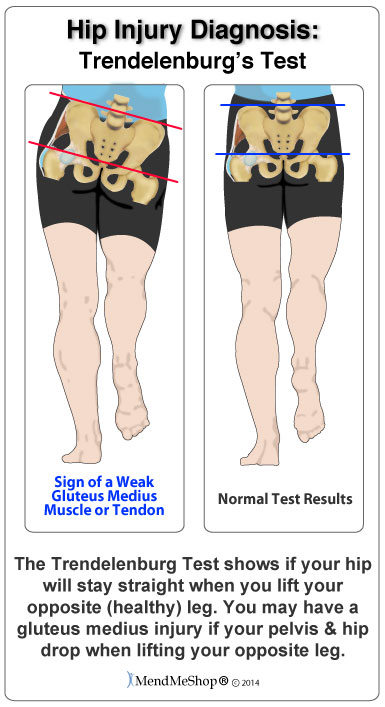 Hip pain is a very common problem and there are many causes of hip pain. It can be hard to discover the condition that you are dealing with. Are you are having trouble sleeping on that side of your hip? Are you having pain standing, walking are after sitting for any length of time? The best way to diagnose this condition is with a visit to your doctor for a physical examination of your hip. During a physical examination of your injured hip, your doctor will be looking for weakness and pain in the hip area. Your hips should be at the same level and they may also look at the results of something called the 'Trendelenburg's Test'. This test is done by standing on one leg and allowing the pelvis to drop on the opposite side while lifting your opposite (healthy) leg/hip. Your doctor will know that you have gluteus medius tendonitis (or weakness in your hip muscles) if you lift the opposite (healthy) leg/hip and you're unable to maintain your balance while you stand (you may also experience a shooting pain) (reference: 1, 2). It's important to have a proper diagnosis from a doctor or some other medical professional to determine the cause of your symptoms. This way the right treatment can be used to treat the condition and relieve your pain. What's the Difference Between Gluteus Medius Tendonitis, Tendinosis and Tenosynovitis?Tendinosis refers to tendon degeneration when there is no inflammation. Tendinosis is often caused by chronic degeneration (wearing away) of tendon fibers over time and is a natural thing that happens to our tissue as we age. However, Tendinosis is also caused from repetitive use without adequate rest between usage (RSI injury). As an example, achilles tendinosis is quite common in runnners as their achilles is under repetitive stress. In a nutshell, Tendinitis relates to tendon inflammation whereas Tendinosis refers to tendon breakdown with no inflammation. Where tendonitis means damage or micro-tearing to your tendon, tenosynovitis is damage or micro-tearing to the sheath covering your tendon. This sheath is a protective lining for your tendon and is made up of synovium. If this sheath is injured it can also become irritated resulting in similar symptoms as tendonitis (pain, swelling and inflammation). It's possible for you to have tendonitis / tendinosis AND tenosynovitis at the same time creating a more complicated hip tendonitis injury. How Do I Cure Gluteus Medius Tendonitis?If you suspect you have tendonitis in your hip,
No one is immune to tendinitis, you can reduce your risk of re-injury with consistent conservative treatments If you have pain and inflammation in your hip, buttock and/or your tail bone, it's very important to heal your injury quickly and completely. You must avoid the build up of scar tissue. If you don't, your hip tendinitis injury may last for a very long time. This is why it's so important to continuously use conservative treatment tools to heal any recurring tendon damage before it can build into something big. For any hip tendinitis sufferer, having the right tools makes all the difference. In mild and moderate cases of tendinitis / strained tendons, your PT will most likely encourage you to augment your sessions with conservative home exercises/treatments. Severe injury to the tendon (ruptured tendons) will require surgery to re-attach the tendon to your bone or bring the edges of the tear together. If you suspect that you've ruptured your tendon be sure to speak with your doctor for suggested treatment. Gluteus Medius Tendonitis Home Conservative Treatment OptionsStep 1 - Reduce Pain and Swelling with Cold CompressionThe first step for conservative treatment of your hip tendinitis is to reduce the swelling to "open up" the area for more blood flow. Anyone in the health-care business knows that your blood supplies the oxygen and much needed nutrients required to heal hip tendinitis injuries. This is why for years, doctors, trainers, and other medical professionals have recommended RICE (Rest, Ice, Compression, Elevation) to treat the pain and swelling of fresh injuries, chronic pain, and after any re-injury. Cold Compression Slows nerve and tissue function - reducing the swelling that blocks blood vessels from doing their job. This is important because once blood vessels are blocked or damaged, they can no longer carry oxygenated blood through the tissue and tissues begin to break-down. Without cold compression, tissue break-down continues as they don't get the oxygen they need to survive. By limiting the amount of damage done to your tendon, you also limit the amount of healing that needs to occur. This is a very important step to heal tendon injuries faster and with less pain! This is why you need to treat your hip pain right after it's hurt, when you notice pain / swelling / inflammation, or directly after a re-injury. Applying a Cold Compress or Ice Pack right away will help stop the damage immediately and unblock your blood vessels to let your body's natural blood flow in to start healing the tissue. Use a Cold Compress or Ice Pack:
Step 2 - Improve Circulation, Soften Scar Tissue & Prevent Re-Injury with a TShellz Wrap®After the inflammation in your hip has been reduced, providing extra blood flow and strengthening soft tissue in the injured area is recommended.  Increased Blood Circulation = Increased Healing CapabilityTShellz Wraps® contain a unique Carbon Fiber Energy Pad which is flexible and will shape to conform to your body. This Energy Pad emits a uniform wave of perfectly safe energy over its entire surface. This energy is absorbed by soft tissue in the treatment area, opening blood vessels, resulting in an increase in blood flow. Increased blood circulation is what your body needs to accelerate the healing of soft tissue and this is why we recommend the TShellz Wrap®. The TShellz Wrap® is an FDA Registered Medical Device and is suitable for use in therapeutic clinics and FROM HOME. It is completely safe for people and patients to use for themselves. The technology found in a TShellz Wrap® has been used for decades in the worlds of professional and amateur sports - a contributing factor as to why athletes seem to recover from injuries so quickly. Have you ever wondered by an athlete can return to activity after 3 or 4 weeks following a soft tissue injury - while your average person takes much longer to return back to normal? The secret isn't really that much of a secret - it involves consistent treatments (meaning multiple times a day) using a treatment like the TShellz Wrap® to stimulate blood flow to the injured tissues. Most athletes have the luxury of using in-house facilities many times per day. How many us can afford the time and money to visit a clinic multiple times a day? Very few indeed. This is how you can gain some of the advantages that athletes enjoy in their injury recovery - by using a device like the TShellz Wrap® two or three times a day on a consistent basis. Consistent Treatments = Consistent And Long Term ImprovementWhat Else Makes the TShellz Wrap® So Special?We believe the TShellz Wrap® to be one of the most effective home treatments to increase localized blood flow to soft tissue in and around the treatment area. We can promise that you will receive a product that is designed to be safe and does what it is supposed to do... reduce pain (as stated in "Therapeutic Heat and Cold", 4th edition. - Ed. Justus F. Lehmann, M.D., Williams, and Wilkin) temporarily increase length & flexibility of soft tissue (as stated in "Therapeutic Heat and Cold", 4th edition. - Ed. Justus F. Lehmann, M.D., Williams, and Wilkin) and aid your body in recovering from tendon, muscle and other soft tissue injuries via enhanced blood flow.  The unit plugs into a standard wall outlet to get its power. The nice thing about the power supply is that the same unit can be used in North America and overseas as well. It has the capability to operate between 110v and 230v. The TShellz Wrap® has a special signal controller that can be set for 3 different power levels of application (3=High, 2=Medium, 1=Low). The cord is long enough that you can sit or lie comfortably and watch TV, read or surf the net while you're using it. Treatments are max 30 minutes in duration and the device can be worn over clothing. This allows you to use the device at work, at home, or really anywhere you have access to an electrical outlet. Conservative Treatment Tools Our Clients Have Used to Help |
 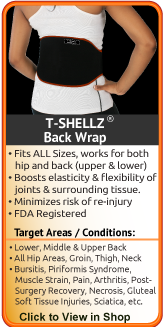       |


